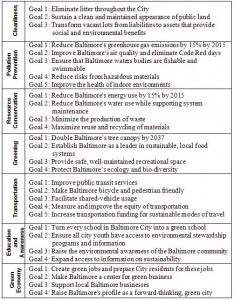Baltimore’s Mayor Stephanie Rawlings-Blake on April 16, 2011, stood up at the city’s Druid Hill Park Conservatory to announce the release of the 2010 Annual Sustainability Report. This yearly accountability tool to track Baltimore’s progress toward improving economic, social, and environmental sustainability was the city’s second such report, a product of the Baltimore Office of Sustainability.
Baltimore defines sustainability as “meeting the current environmental, social, and economic needs of our community without compromising the ability of future generations to meet these needs.” This is deceptively similar to the often quoted formulation of the United Nations Brundtland Commission. Our Common Future, that Commission’s 1987 report, asserted that “Sustainable development is development that meets the needs of the present without compromising the ability of future generations to meet their own needs.” The concept of needs was explained with particular priority of concern for the world’s poor. Our ability to meet needs was represented as limited by our social organization and technology as well as environmental constraints.
Read literally, Baltimore’s idea of sustainability differs in two possibly controversial ways from conventional usage. First, development–meaning steady increase of living standards and economic activity–is not mentioned. Second, the needs that future generations will want to meet seemingly are presumed not to differ from ours today. But perhaps, for Baltimore’s sustainability assessors, development is a fundamental need.
In any case, the report is structured around 29 specific goals in seven clusters aimed at enhancing the city’s sustainability. Some of the goals are quite specific (for example, reducing greenhouse gas emissions by 15% by 2015), but most are open ended. And with the possible exception of supporting local business, every goal is crucially linked to the region’s public works infrastructure, although infrastructure is cited explicitly as a contributing resource for only about one-third.
By 2022, the Baltimore Office of Sustainability had issued a total of 9 annual reports and a 2019 Baltimore Sustainability Plan. The city’s website concludes, “Sustainability is about strengthening our city through collaborative action. It’s about balancing social equity, economic growth, and environmental action. It’s about the need for justice, equity, inclusion and diversity in everything we do — recognizing that these are absolutely imperative to combating the challenges we face.”

